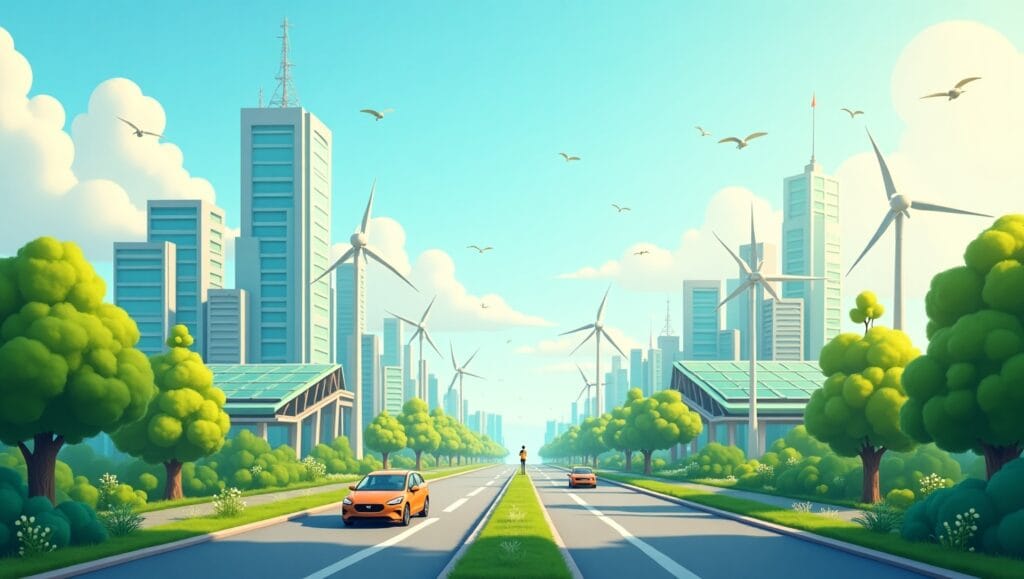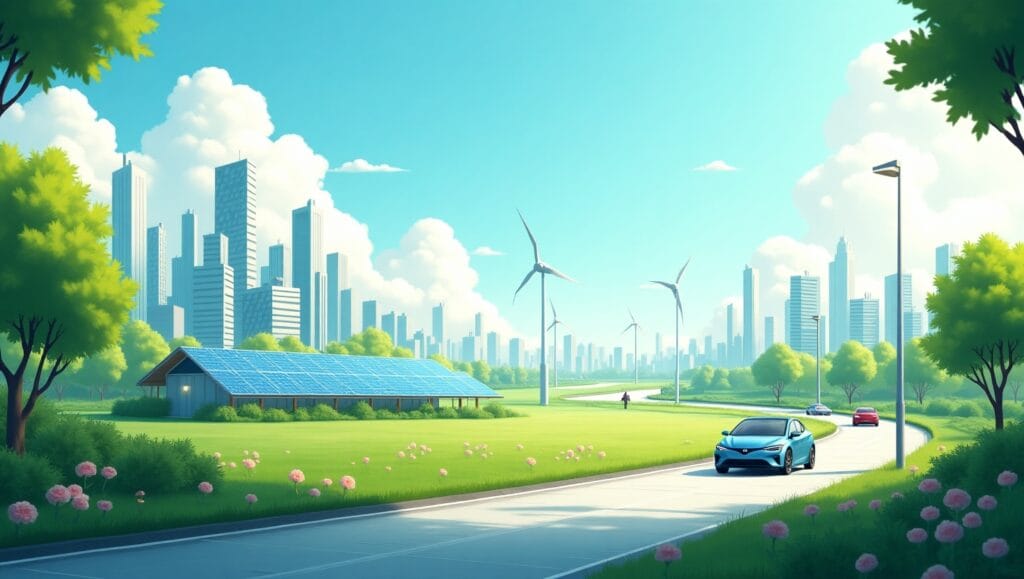
Introduction: The Greener Future Tech Revolution Is Here
As the world faces unprecedented environmental challenges—rising temperatures, worsening air quality, and depleting resources—technology is stepping in not as part of the problem, but increasingly, as part of the solution.
From renewable energy innovations to carbon capture systems and eco-conscious product design, we are entering an era where sustainability is the driving force behind technological progress.
Governments, corporations, and startups alike are investing in sustainable technologies to address climate change, reduce emissions, and build a future that is not just smarter—but also greener.
Why Sustainable Technology Matters Now
The urgency to adopt sustainable tech is being driven by:
- Escalating climate change impacts
- Pressure to reduce industrial carbon footprints
- Depleting non-renewable resources
- Growing consumer demand for ethical, green products
In short, innovation with impact is becoming the new global standard.
🌱 The Driving Forces Behind Sustainable Technology Adoption
The global shift toward sustainable technology isn’t just a passing trend—it’s a necessary response to urgent environmental, economic, and social challenges. Several forces are accelerating the adoption of these innovations:
1. Climate Change and Resource Scarcity
As global temperatures rise, extreme weather events become more frequent, and natural resources like water, minerals, and fossil fuels become scarce, governments and corporations are under pressure to adopt solutions that reduce environmental damage. Sustainable technologies—such as renewable energy systems, energy-efficient manufacturing processes, and waste-reduction innovations—directly address these issues.
2. Corporate Sustainability Commitments
Global brands like Apple, Tesla, and Microsoft have made bold pledges to achieve carbon neutrality or even become carbon negative within the next decade. This commitment drives investments in sustainable manufacturing, recycling programs, and clean energy adoption—setting a precedent for other industries to follow.
3. Government Incentives and Policies
Countries worldwide are introducing tax breaks, subsidies, and research grants for companies adopting sustainable technology. In the U.S., the Inflation Reduction Act of 2022 allocated billions for clean energy projects, battery development, and electric vehicle infrastructure—creating a thriving market for green innovation.
🔋 Breakthrough Innovations Shaping a Greener Future
1. Next-Generation Energy Storage
While renewable energy sources like solar and wind are expanding rapidly, their intermittent nature means we need better storage solutions. Advanced solid-state batteries, hydrogen fuel cells, and AI-driven grid management systems are making clean energy more reliable and accessible.
2. Circular Economy Technology
The “take-make-dispose” model is being replaced by “reduce-reuse-recycle” systems powered by technology. AI-powered waste sorting, biodegradable materials, and upcycling processes are making it possible to keep products in use for much longer—reducing landfill waste and conserving resources.
3. Green Data Centers
With the AI boom, data center energy consumption has skyrocketed. Tech giants are now designing carbon-neutral data centers powered entirely by renewable energy, with advanced cooling systems that reduce water and electricity usage by up to 50%.
🌍 The Role of AI in Sustainable Technology
Artificial Intelligence is becoming the brain behind many green technologies:
- Smart Energy Grids use AI to predict electricity demand and optimize distribution, reducing waste.
- Precision Agriculture leverages AI-powered drones and sensors to monitor crop health, minimize pesticide use, and optimize irrigation.
- Sustainable Supply Chains are using AI to forecast demand, prevent overproduction, and lower transportation emissions.
By 2030, the AI-powered sustainability market is expected to be worth over $40 billion, making it one of the fastest-growing sectors in green tech.
🚀 Challenges and the Road Ahead
While the outlook for sustainable technology is promising, challenges remain:
- High Initial Costs – Many green solutions require significant upfront investment, which can deter smaller businesses.
- Technology Gaps – Developing countries may lack the infrastructure to fully adopt sustainable technologies.
- Global Coordination – Without unified international policies, adoption rates and effectiveness may vary dramatically.
However, with continued innovation, public awareness, and policy support, sustainable technology has the potential to not only combat climate change but also create millions of green jobs worldwide.
Explore : Greener Future

Key Areas of Sustainable Tech Innovation
1. Green Energy Solutions
From solar panels to wind turbines, renewable energy is no longer experimental—it’s mainstream.
- Perovskite solar cells are pushing solar efficiency to new highs.
- Next-gen wind farms use AI to optimize turbine placement and performance.
- Battery storage systems, like Tesla’s Megapack, help store excess green power for later use.
2. Carbon Capture & Storage (CCS)
Reducing emissions is one part of the puzzle. The other? Capturing the carbon that’s already in the atmosphere.
Innovations include:
- Direct Air Capture (DAC) machines pulling CO₂ straight from the air
- Biochar—a carbon-rich soil additive that locks away emissions
- Ocean-based carbon removal, such as kelp farms absorbing CO₂ and storing it underwater
Big tech players like Microsoft and Stripe are already investing millions in carbon removal tech.
3. Sustainable Product Design
Green tech doesn’t stop at power generation—it extends to how products are made, used, and recycled.
Modern sustainable design trends include:
- Biodegradable electronics
- Recyclable packaging made from mushroom mycelium or seaweed
- Modular smartphones that reduce e-waste (like the Fairphone)
- 3D-printed buildings using sustainable materials like hempcrete or recycled plastic

Industry Shift: Big Tech Goes Green
Many global tech firms are leading the green charge:
| Company | Sustainability Initiative |
|---|---|
| Apple | 100% recycled aluminum in Macs, carbon-neutral goal by 2030 |
| AI-driven energy efficiency in data centers | |
| Microsoft | Negative carbon footprint by 2030 |
| Tesla | EV battery recycling and solar energy production |
| Amazon | Climate Pledge aiming for net-zero carbon by 2040 |
The Business Case for Sustainability
Sustainability is no longer just a social responsibility—it’s good business. Companies embracing green tech are:
- Attracting more investors
- Building stronger brand trust
- Tapping into a growing base of eco-conscious consumers
- Preparing for future regulatory compliance
Startups and innovators in the cleantech sector are also gaining attention from VC firms and climate funds globally.
Challenges Ahead
Despite massive progress, some hurdles remain:
- High initial costs of green tech implementation
- Scalability issues for newer technologies
- Lack of policy incentives in some regions
- Need for global cooperation to enforce standards
Governments must step up with infrastructure support, incentives, and R&D funding to push adoption further.
Future Outlook
The next decade will likely see:
- Ultra-efficient, AI-optimized renewable grids
- Fusion energy breakthroughs
- Fully circular manufacturing ecosystems
- AI models focused on environmental problem-solving
Sustainable technology will not only shape the climate fight but also redefine how we build economies, design products, and live our lives.
🌟 Real-World Examples of Sustainable Technology in Action
While the concept of sustainable technology may sound futuristic, it’s already being implemented worldwide—often in ways you might not expect.
1. Tesla’s Energy Ecosystem
Tesla isn’t just about electric cars anymore—it’s building a complete energy ecosystem. The Tesla Powerwall and Megapack store excess solar power for later use, allowing homes and businesses to operate completely off-grid. In California, Tesla’s battery farms are helping stabilize the power grid during peak demand.
2. Vertical Farming in Urban Spaces
Cities like Singapore and Dubai are adopting vertical farming systems powered by AI and LED lighting. These farms use 90% less water than traditional agriculture and can grow food year-round without pesticides. This could be a game-changer in tackling global food insecurity.
3. Ocean Cleanup Projects
Organizations like The Ocean Cleanup are deploying AI-powered boats and floating barriers to remove millions of tons of plastic waste from oceans and rivers. This technology not only cleans existing waste but also prevents future pollution from reaching open waters.
📊 The Economic Impact of Green Innovation
Sustainable technology isn’t just good for the planet—it’s proving to be a massive economic opportunity.
- Market Size – The global green technology and sustainability market is expected to reach $74 billion by 2030, growing at a CAGR of over 20%.
- Job Creation – The clean energy sector already employs over 12 million people worldwide—a number that could triple by 2050.
- Business ROI – Studies show companies that adopt sustainable practices see up to 20% cost savings from reduced waste and energy use.
Investors are taking notice too—ESG (Environmental, Social, and Governance) investing hit $2.5 trillion in 2024, with funds pouring into renewable energy, clean transportation, and eco-friendly manufacturing.
🌿 How Individuals Can Embrace Sustainable Technology
You don’t have to be a tech giant to make a difference. Individuals can integrate sustainable technology into their lives in several ways:
- Smart Home Devices – Install energy-efficient smart thermostats, lighting systems, and appliances that reduce electricity usage.
- Green Commuting – Switch to electric or hybrid vehicles, use public transportation, or adopt e-bikes for short trips.
- Eco-Friendly Tech Products – Opt for laptops, smartphones, and gadgets made with recycled materials and low-energy components.
- Home Solar Systems – Even small-scale rooftop solar panels can drastically cut utility bills and carbon emissions.
🚀 The Future: Sustainable Technology by 2035
Looking ahead, the integration of sustainable technology will likely transform every industry:
- AI-Managed Smart Cities – Entire urban areas will be monitored and optimized for energy use, traffic flow, and air quality.
- Carbon-Negative Manufacturing – Factories will actively capture and store carbon rather than emit it.
- Fusion Energy Breakthroughs – Clean, virtually limitless fusion power could become a commercial reality.
- Personal Carbon Trackers – Wearable devices may track individual carbon footprints and suggest eco-friendly actions in real time.
📢 Final Thoughts
Sustainable technology represents more than innovation—it’s a global movement toward resilience, economic growth, and environmental responsibility. As we enter this new era, the choices we make today will determine whether the green revolution becomes a permanent part of our future or a missed opportunity.
Stay ahead of innovation—follow USAtrends.tech for daily updates on emerging technology.





